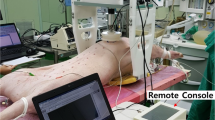Abstract
A totally self-contained instrument for the measurement of cardiac output is described. The microcomputer controlled instrument is based upon the principles of thermodilution and is capable of making cardiac output determinations on a minute by minute basis. A bolus of heat is delivered to the blood via a resistive heating element wound on the surface of a conventional thermodilution catheter, and the resulting transient pulmonary artery blood temperature increase is monitored with the thermistor located near the tip of the catheter. The performance of the instrument was tested in a mock circulatory loop and in dogs for periods of up to 13 hours. The accuracy and reproducibility of flow determinations made with the system compare favorably with those made with a conventional cardiac output monitor. This study demonstrates the feasibility of a stand-alone cardiac output computer that can provide virtually continuous measurements of blood flow without the intervention of a technician.
Similar content being viewed by others
References
Afonso, S.; Herrick, J.F.; Rowe, G.G.; Crumpton, C.W. Temperature variations in the venous system of dogs. Am. J. Physiol. 202:278–282; 1962.
Forrester, J.S.; Ganz, W.; Diamond, G.; McHugh, T.; Chonette, D.W.; Swan, H.J.C. Thermodilution cardiac output determination with a single flow-directed catheter. Am. Heart J. 83:306–311; 1972.
Ganz, W.; Swan, H.J.C. Measurement of blood flow by thermodilution. Am. J. Cardiol. 29:241–246; 1972.
Ganz, W.; Donoso, R.; Marcus, H.S.; Forrester, J.S.; Swan, H.J.C. A new technique for measurement of cardiac output by thermodilution in man. Am. J. Cardiol. 27:392; 1971.
Hamilton, W.F.; Riley, R.L.; Attyah, A.M.; Cournand, A.et al. Comparison of the Fick and dye injection methods of measuring the cardiac output in Man. Am. J. Physiol. 153:309–321; 1948.
Johnson, R.W. Heat Transport Through the Heart with Applications to Thermodilution Signal Processing. Ph. D. Dissertation, University of Utah; 1987.
Johnson, R.W.; Normann, R.A. Mathematical and mechanical modeling of heat transport through the heart. Ann. Biomed. Eng.; in press.
Johnson, R.W.; Normann, R.A. Signal processing strategies for the enhancement of the signal to noise ratio of thermodilution measurements. Ann. Biomed. Eng.; 16:265–278; 1988.
Philip, J.H.; Long, M.C.; Quinn, M.D.; Newbower, R.S. Continuous thermal measurement of cardiac output. IEEE Trans. on Biomed. Eng. 31:393–399; 1984.
Riedinger, M.S.; Shellock, F.G. Technical aspects of the thermodilution method for measuring cardiac output. Heart and Lung 13:215–221; 1984.
Thompson, R.B.Disorders of the Blood. Edinburgh: Churchil Livingstone; 1978.
Wessel, H.U.; James, G.W.; Paul, M.H. Effects of respiration and circulation on central blood temperature of the dog. Am. J. Physiol. 211:1403–1412; 1966.
Author information
Authors and Affiliations
Rights and permissions
About this article
Cite this article
Normann, R.A., Johnson, R.W., Messinger, J.E. et al. A continuous cardiac output computer based on thermodilution principles. Ann Biomed Eng 17, 61–73 (1989). https://doi.org/10.1007/BF02364273
Received:
Revised:
Issue Date:
DOI: https://doi.org/10.1007/BF02364273




